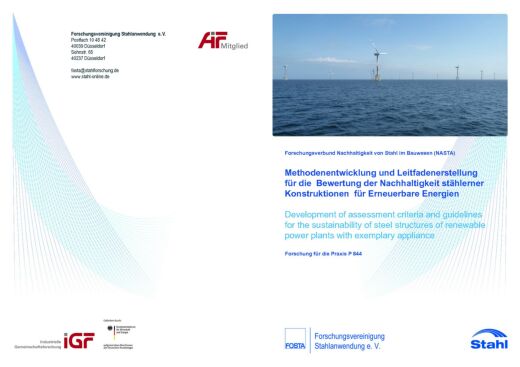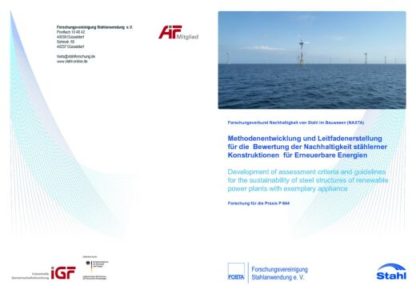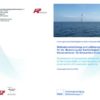Description
P 844 – Development of assessment criteria and guidelines for the sustainability of steel structures of renewable power plants with exemplary appliance
The research project aimed on the one hand to develop a method for evaluating the sustainability of steel support structures of plants producing renewable energy by considering demands of the power plant, energy and building industry. On the other hand the project aimed to work out criteria and indicators in relevant categories of the sustainability for renewable energy sources and to provide a guideline enabling a sustainability assessment by using the developed evaluation method.
At the beginning the plant, energy and building technologies of the five renewable energies wind, solar, biomass, water and geothermal were ascertained and composed. For each of these technologies the current situation and future for Germany was investigated and analyzed regarding the potential steel amount of each technology. As a consequence of this study the interesting key technologies in Germany, the wind energy onshore and offshore as well as the biogas power plant sector, was derived and in agreement with the project supporting expert group focused during the project.
Material flows for these technologies were established and constituted the basis for developing the sustainability assessment method. Referring to existing and well-proven assessment methods from the building sector the five sustainability categories ecological, economical, social, technical and process quality were defined. Transferable criteria and indicators from the assessment method in the building industry were identified in each of these categories and supplemented by criteria from the renewable and steel industry to characterize the sustainability of the steel support structure of renewable energies. From these over 200 criteria and indicators collected in a criteria catalogue, 35 criteria were identified to be of significance for the evaluation of steel support structure for renewable. For each criteria a profile was written containing the definition, the relation to one of the sustainability categories and considering the procedure for the data ascertainment. The developed sustainability assessment method enables to develop for each sustainability category a polar diagram showing the sustainability effect of the analysed steel construction.
In order to have a simple application of the developed method not only by using the brief profiles and method description, a software tool was developed. By means of an input surface the subsequent user has the chance to have a tool generating quickly and clearly the sustainability assessment of the steel construction. In addition the developed tool helps to compare different constructions regarding their sustainability, so that not only the most sustainable construction can be achieved but also the optimization potential for each category can be analyzed. Conducted and depicted sustainability assessments of exemplary steel construction give further advice to the subsequent user of the method.
The research project (IGF-Nr. 16599 N) was carried out at Gottfried Wilhelm Leibniz Universität Hannover vom Institut für Stahlbau, at Ruhr-Universität Bochum vom Lehrstuhl für Energiesysteme und Energiewirtschaft and at Universität Duisburg-Essen vom Institut für Metall- und Leichtbau. FOSTA has accompanied the research project work and has organized the project funding from the Federal Ministry of Economics and Technology through the AiF as part of the programme for promoting industrial cooperation research (IGF) in accordance with a resolution of the German parliament.
Only available in german language.
Authors:
P. Schaumann, A. Bechtel, R. Eichstädt, H. J. Wagner, C. Baack, J. Lohmann, N. Stranghöner, J. Berg, A. Gorbachov
Published in:
2016




